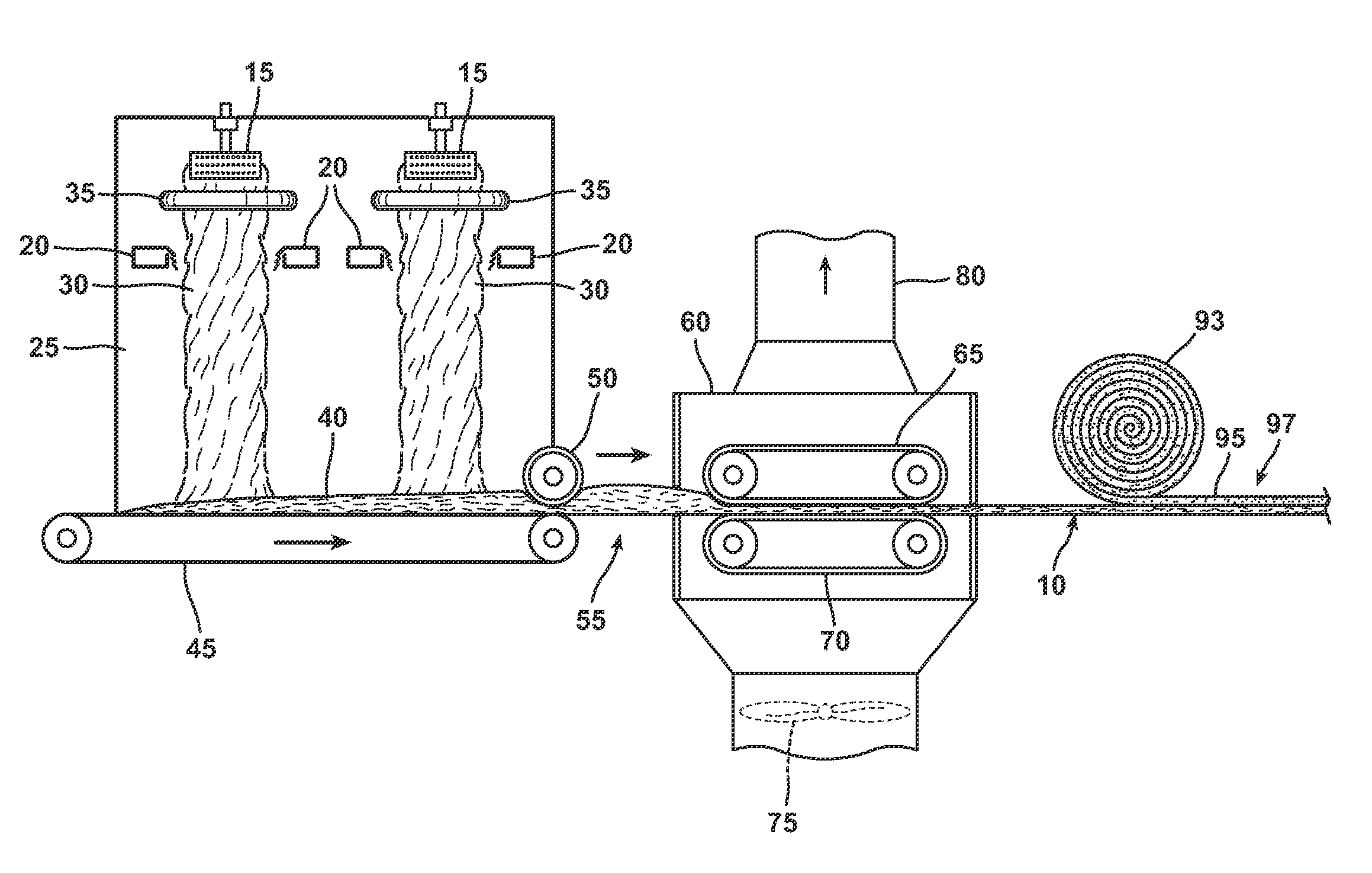Modified starch based binder
a starch-based, modified technology, applied in the field of binding, can solve the problems of unstable urea-extended resoles, ammonia is not a particularly desirable alternative, and irritation of workers' throats and noses, and achieves excellent resistance to water, reduce manufacturing costs and gaseous emissions, and be readily availabl
- Summary
- Abstract
- Description
- Claims
- Application Information
AI Technical Summary
Benefits of technology
Problems solved by technology
Method used
Image
Examples
example 1
[0064]Samples of binder formulations according to Table 4 were prepared according to the following procedure. First, the crosslinker (i.e., citric acid, Kymene®, or QXRP 1734) was added to water in a first container. In a separate, second vessel, the starch was modified by the addition of suitable quantities of sulfuric acid. The modified starch dispersion was added to the crosslinker / water solution to form a stock mixture. The cure accelerator (i.e., sodium hypophosphite) and the silane (i.e., γ-aminopropyltriethoxysilane) were added to the stock solution to form the binder compositions.
TABLE 4TotalSolids (%)(as40%20%100%38%52%received2%SodiumModifiedCitricKymene ®QRXPSample(g))WaterSilaneHypophosphiteStarch(1)Acid736(2)1734(3)18005996.002.0019328006226.002.001645.6938006136.002.0016414.9748006176.002.0016410.88(1)a modified starch with a viscosity from 2-45 cps at 9% solids (from 200-625 cps at 22% solids)(2)an aqueous solution of a cationic amine polymer-epichlorohydrin adduct (c...
example 2
[0067]Samples of binder formulations according to Table 6 were prepared according to the following procedure. First, the crosslinker (i.e., citric acid) was added to water in a first container. In a separate, second vessel, the starch was modified by the addition of suitable quantities of sulfuric acid. The modified starch dispersion was added to the crosslinker / water solution to form a stock mixture. The cure accelerator (i.e., sodium hypophosphite) and the silane (i.e., γ-aminopropyltriethoxysilane) were added to the stock solution to form the binder compositions.
TABLE 6TotalSolids (%)(as40%100%20%received2%SodiumCitricModifiedSample(g))WaterSilaneHypophosphiteAcidStarch(1)18006016.041.9119128006246.041.915.7416338006035.7419148006265.745.72162(1)a modified starch with a viscosity from 2-45 cps at 9% solids (from 200-625 cps at 22% solids)
[0068]The binder formulations set forth in Table 6 were then utilized to form handsheets in a manner known by those of skill in the art. The han...
example 3
[0070]Samples of binder formulations according to Table 8 were prepared according to the following procedure. First, the crosslinker (i.e., triethanol amine, glycerol, citric acid, or QXRP 1734) was added to water in a first container. The modified starch dispersion (i.e., Super Film® 270W) was added to the crosslinker / water solution to form a stock mixture. The cure accelerator (i.e., sodium hypophosphite) and the silane (i.e., γ-aminopropyltriethoxysilane) were added to the stock solution to form the binder compositions.
TABLE 8Solids (%)Total18%(as40%Super50%received2%SodiumFilm ®100%QRXPSample(g))WaterSilaneHypophosphite270W(1)Crosslinker1734(2)18004359.6035628004359.6035638004799.60302TriethanolAmine9.648004799.60302Glycerol9.658004799.60302Citric Acid9.668004699.6030219.278005187.8014488004329.603.20356(1)a modified starch with a viscosity from 2-45 cps at 9% solids (commercially available from Cargill)(2)a polyacrylic acid resin (commercially available from The Dow Chemical Co...
PUM
| Property | Measurement | Unit |
|---|---|---|
| temperatures | aaaaa | aaaaa |
| diameter | aaaaa | aaaaa |
| diameter | aaaaa | aaaaa |
Abstract
Description
Claims
Application Information
 Login to View More
Login to View More - R&D
- Intellectual Property
- Life Sciences
- Materials
- Tech Scout
- Unparalleled Data Quality
- Higher Quality Content
- 60% Fewer Hallucinations
Browse by: Latest US Patents, China's latest patents, Technical Efficacy Thesaurus, Application Domain, Technology Topic, Popular Technical Reports.
© 2025 PatSnap. All rights reserved.Legal|Privacy policy|Modern Slavery Act Transparency Statement|Sitemap|About US| Contact US: help@patsnap.com



